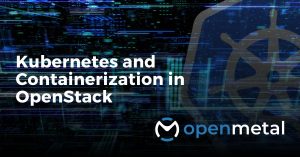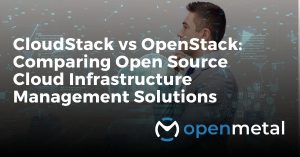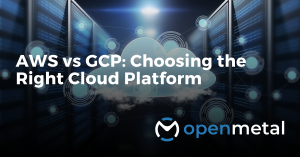
In this blog:
- Acquisition of VMware
- The OpenStack vs VMware Alternative
- The World is Beginning to Run on OpenStack
- Cloud Costs You Need to Understand
- Why Aren’t More Companies on OpenStack?
- OpenMetal On-Demand Private Clouds Bring It Together
Without question, VMware has a good reputation for cloud security and virtualization within a single management framework. I will even admit to having been an active promoter and fan of VMware’s NSX capabilities in my previous roles with other cloud providers. It is a solid system. But, given its high price point compounded with new acquisition uncertainties, now may be a good time to reevaluate your options. More so, it may be a good time to consider adopting OpenStack vs VMware.
Fear of an Acquisition Planet
In late May of 2022, Broadcom announced its acquisition of VMware for $61 billion dollars. Its stated intention is to switch their own brand to VMware brand and integrate its semiconductor and infrastructure software solutions into an expanded VMware portfolio.
On paper, this new relationship seems to signal more opportunities for VMware customers. However, there is an underlying concern that this acquisition will follow the same behaviors as Broadcom’s previous purchases of CA Technologies in 2018 and Symantec in 2019. In both of these scenarios, customers experienced the company’s desire for maximum ROI and profitability over customer services or retention, leading to:
- Service Reductions – Symantec abandoned most of its 100,000 user base to focus on 2,000 of its most profitable customers. This left customers scrambling to find new cloud and endpoint security solutions.
- Staffing Reductions – Both organizations experience cost-cutting staffing reduction post acquisition with a reported 40% headcount reduction at CA Technologies and a 7% headcount reduction at Symantec.
- Massive Price Increases – CA Technologies users saw price increases ranging from 100% to 450%. Some Symantec users saw increases between 82% and 142%.
Time will tell if this acquisition of VMware will be different. But, market analysts seem convinced that some of these same old behaviors may arise with the VMware acquisition as well, increasing the need for robust Exposure Management to mitigate potential risks in cloud service reliability and costs.
The Market View
A new survey by 451 Research, part of S&P Global Market Intelligence, revealed strong concerns around this acquisition. This concern was mostly directed around current Broadcom and VMware customers. The three main worries on the list include:
- The pace of innovation will be stifled.
- The general lack of obvious synergies between the two companies.
- The potential impact on software licensing terms and conditions.
Gartner released an article titled “Quick Answer: How Should VMware Customers Prepare for the Broadcom Acquisition?” This article gets right to the point by advising VMware users to “Identify exit ramps for deployed products, including alternative solutions and migration activities.”
It is impossible to truly predict what will happen. But, as uncertainty looms, it is a good motivation to reevaluate your options. If you are a small to mid-sized business, history has shown even more challenges for you after these acquisitions than larger enterprise clients.
If you are a VMware customer, you need to take a moment to decide what specifics of your service are most critical. What is most important to you and your own future growth? Should things go in a negative direction, you need to be prepared to decide if you are willing to accept any new costs or changes to service. Or, are there new options out there that you may have not considered before?
The OpenStack vs VMware Alternative
Being an open source cloud platform with no dependencies to a single company, OpenStack can help to directly address the common concerns addressed above. When you are comparing OpenStack vs VMware, it’s good to keep the following point top of mind.
No Proprietary Hardware or Software Licensing
OpenStack, was built vendor-agnostic, which means it is designed to run on regular hardware and support hyper-converged architectures where nodes are the same and provide compute, control, and networking and storage services (such as Ceph). Likewise, being an open source software, OpenStack is available under the Apache licenses to make it openly available to anyone to be used for free without any limitations.
No Vendor Lock-In
Because the platform has no dependencies to any hardware or software vendors, OpenStack removes all necessary commitments to any single vendor. With OpenStack, you are in control of provisioning your own cloud resources. If you do not like the vendor supporting your OpenStack platform, you can just move on to another.
A Global Support Community
As of 2020, OpenStack had a community of users more than 110,000 strong, spread out all over the globe. The significance of this is that these are “active” community members that tend to support one another and drive continued development to the platform on an ongoing basis. They do not do this as a job. They do it because they are passionate about making this technology open and available to all. While this cannot be expected to replace dedicated internal staff and/or support teams, it does give participating companies access to a world of problem solvers ready to help resolve issues that may arise.
The World is Beginning to Run on OpenStack
If you have skepticisms of open source cloud, you may be asking, “Is open source—or specifically in this case, OpenStack—really a serious alternative for my VMware cloud services?” The answer is yes. In fact, acceptance and adoption of OpenStack has been rapidly growing.
According to a survey by the Open Infrastructure Foundation, there are now more than 25 million cores of OpenStack compute in production. This marks a 66% increase in total cores year over year, including premier brands like Target, Progressive, GE Healthcare, Nike, and others are adopting OpenStack to run their workloads. But why? What is inspiring this new adoration for OpenStack?
Many will claim that a growing community of open source advocates or community members is the catalyst for a growing movement towards OpenStack adoption. And yes, there are many users motivated by the frustration of dealing with a growing market dominance of mega cloud providers like AWS, Azure, and the Google Cloud Platform (GCP). But ideology will only work for so long. The platform needs to demonstrate real business value and established protocols. And, as addressed above, it does.
Cloud Costs You Need to Understand
OpenStack is a true cloud infrastructure vs VMware being a virtualized infrastructure. But, while built on different architectures and ecosystems, they do have multiple overlapping functionalities. In fact, VMware actually integrates with OpenStack. Therefore, platform decisions really come down to how your team “prefers” to manage your cloud operations.
There is no right answer when it comes to which platform performs better. However, it is important to understand key business-related issues that could impact your success. This is especially true for those looking to deploy private cloud environments. One of the most important factors is to look at the ways each platform impacts bottom line costs.
Licensing Costs
You would think that a cloud solution would alleviate the worries of hardware and software licensing costs. Obviously, all cloud services operate on physical hardware and software somewhere. However, when you move to the cloud, the last thing you want to worry about is monthly licensing expenses. Yet, VMware makes it hard to escape.
VMware offers virtualization services through a proprietary sourced platform, owned and operated by VMware. The word to pay attention to in that statement is “proprietary”. That’s because VMware is built to operate on specific, special-purpose hardware and software. Special purpose, of course, is a nice way of saying that it involves costly licensing fees. And, the more access you need to higher levels of services, the more you will be expected to pay.
These licensing costs are a significant portion of VMware’s monthly costs. According to a Trefis report on VMware’s reported revenues, software licensing accounted for 43% of total revenue in 2020. With the acquisition by Broadcom, there are concerns that these licensing costs will become even more painful for users.
VMware had already been making adjustments to its licensing costs, with a move to a per-CPU model. This caused significant price hikes (up to 2X) for new licenses on servers with more than 32 cores. Now, it is reported that Broadcom intends to move away from enterprise software licenses over the next couple of years to a 100% subscription-based model. Broadcom’s own CEO told the media and analysts on a call, “We are going to focus on going through a transition, and a rapid transition, from [VMware] perpetual licensing to subscription.”
On the surface, this move seems like it should be a positive change to simplify billing and bring down user costs. In the short run, it is predicted that this move may even negatively affect new VMware sales.
OpenStack vs VMware Considerations
As noted in Cloud Costs: Part One, OpenStack was built vendor-agnostic, designed to run on regular hardware and available under the Apache Licenses to make it openly available to anyone to be used for free without any limitations.
Vendor Lock In
Vendor lock-in refers to a situation where customers are not able to easily move their products or services from one vendor to another. This is typically because of incompatibilities or dependency on proprietary hardware and software. But some pricing models also have the ability to restrict or complicate customers from easily moving from one vendor to another.
We have already established above that VMware very much depends on special-purpose hardware and software that adds costs. But, the move to a subscription-based model can also lead to a vendor lock-in situation. Based on historical actions seen in the aftermath of Broadcom acquisitions, many fear that the real purpose for a transition to a subscription-based model is that it will allow VMware to:
- Remove term discounting frequently used to attain and retain high value clients.
- Increase services costs if and when VMware chooses to do so.
- Limit price negotiations.
- Gain leverage over customers on their service.
To be fair, a subscription-based model can also give customers the advantage of not being locked into long-term contracts. But, cloud migrations are not something that can be executed quickly or easily. Therefore, if VMware chooses to increase costs at any time, a migration off of VMware’s platform will be exceedingly difficult to accomplish in a timely and cost-effective way.
OpenStack vs VMware Considerations
As noted in Cloud Costs: Part One, OpenStack has no dependencies to any hardware or software vendors, removing all necessary commitments to any single vendor.
Staffing and Support
VMware has a historically good reputation for support. But that support comes at a cost. VMware uses a similar pricing model to support services that they use for licenses. The more CPUs there are in your cluster the more you are going to pay. But as addressed above, the move to a subscription-based model may drastically change expectations.
The biggest issue that arises with support is the internal staffing required to operate and maintain the VMware platform. Because of the proprietary nature of VMware, an understanding of the platform amounts to obtaining specialized skills. This makes it difficult and costly to hire and train staff, and/or maintain ongoing certifications.
The average cost to complete a VMware certification in the U.S. is around $4,500. With these skills being in such high demand, a study conducted by Scale Computing and Spiceworks showed that 1 in 5 staffers tend to leave after being trained for higher paying jobs. This ends up costing companies up to twice (2x) their salaries to replace each of them.
OpenStack vs VMware Considerations
As noted in Cloud Costs: Part One, OpenStack has a community of users more than 110,000 strong, providing access to a world of problem solvers ready to help resolve issues that may arise.
Why Aren’t More Companies on OpenStack?
While there are so many attractive options available to OpenStack users, there are still a number of common concerns and drawbacks that cause users hesitation to adoption:
- Support – Not being owned or directed by any one vendor or team can make it difficult to obtain support for the technology, beyond the open source community.
- Consistency – The OpenStack platform tends to always be changing as new components and services are added and others are deprecated, making it difficult to stay up-to-date on release series
- Complexity – Because of its size and scope, OpenStack is not always the easiest platform to deploy and make work the way one may want. In some cases, an organization might require additional staff or a consulting firm to deploy OpenStack, which can add time and cost.
OpenMetal On-Demand Private Clouds Bring it Together
Until now, organizations seeking to benefit from the cost advantages of OpenStack had to confront these obstacles. The largest hurdle to overcome always seem to be the design and deployment of those first cloud environments. In fact, it was not unheard of for private clouds on OpenStack to take weeks or months to build and deploy successfully. It was worth the investment in the end. But the time to do so was a heavy burden. That has now changed with OpenMetal On-Demand Private Clouds.
Incubated out of parent company InMotion Hosting, OpenMetal rolled out with 20+ years of hosting experience behind it. Its mission is to “Make highly complex open source systems available on demand to increase accessibility for smaller teams.” As a result, OpenMetal created a private cloud, built on OpenStack, that can be built and deployed within 45 seconds. Yes…seconds.
OpenMetal On-Demand Private Clouds include a hyper-converged set of 3 servers of chosen hardware, powered by OpenStack and Ceph. It delivers everything from VM to block storage, as well as ultra-modern services like Kubernetes and Secrets-as-a-Service.
This new “alternative” cloud platform blurs the line between private and public clouds. It provides the security and cost-effectiveness of a private cloud at the speed and ease of a public cloud. This enables users to rapidly spin private cloud instances up and down for testing and production, just like public clouds.
OpenMetal Alleviates Common OpenStack Roadblocks
- Support Available – OpenMetal offers strong hosting service level agreements (SLAs) and maintenance on infrastructure and assisted OpenStack support. Additionally, customers have access to rich documentation and toolsets.
- Maintains Consistency – OpenMetal monitors and manages all used operational release series. This ensures a seamless transition for any changes or updates.
- Simplifies Complexity – OpenMetal makes access to your own OpenStack environment as easy as a few online clicks. This allows you to spin private clouds up or down as needed.
- Control Over Cloud Costs – OpenMetal controls costs through hourly or term pricing options, pricing by hardware, and the ability to set strict cost limits. This enables predictable and transparent costs.
Interested in Learning More?
OpenMetal and OpenStack together deliver a competitive alternative to VMware. But don’t take our word for it:
- Schedule a meeting with the OpenMetal team to discuss your unique needs or a custom Proof of Concept (PoC)
- Request an OpenMetal On-Demand Private Cloud Trial to experience the performance and benefits for yourself or your organization.
More From OpenMetal…

Kubernetes and Containerization in OpenStack
When considering OpenStack and Kubernetes, it is important to note that they do not compete with each other, rather, they are complementary projects. OpenStack is an infrastructure software, its priority is to manage your infrastructure resources …. Read More

CloudStack vs OpenStack: Comparing Open Source Cloud Infrastructure Management Solutions
CloudStack and OpenStack are two prominent open source solutions for cloud infrastructure management; understanding the key differences between them is crucial when choosing the right… Read More

AWS vs GCP: Choosing The Right Cloud Platform
AWS and GCP are leading players in cloud computing, offering a wide range of services and attractive pricing. However, choosing the right platform requires understanding their strengths, customer pain points, and alternatives. Comparing and shopping around for … Read More
Test Drive
For eligible organizations, individuals, and Open Source Partners, Private Cloud Cores are free to trial. Apply today to qualify.
Subscribe
Join our community! Subscribe to our newsletter to get the latest company news, product releases, updates from partners, and more.


































